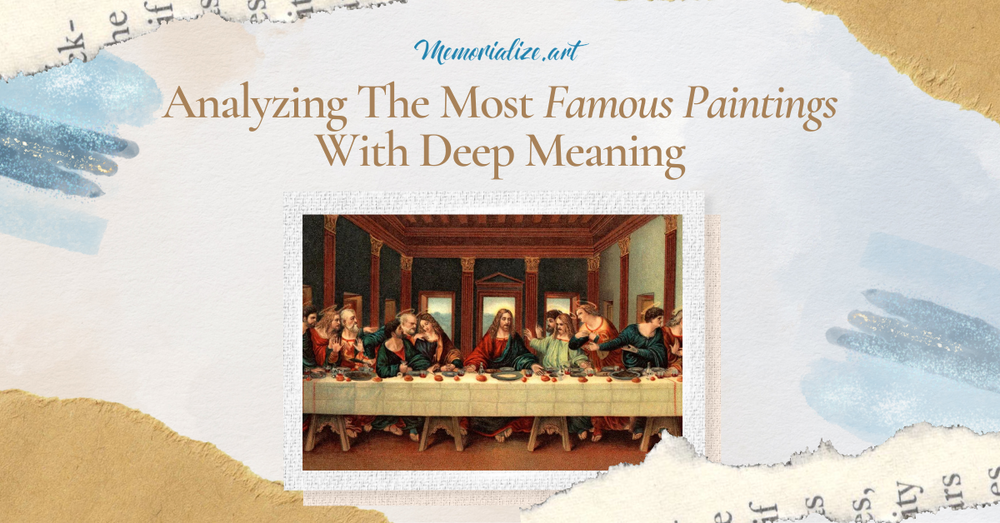Analyzing The Most Famous Paintings With Deep Meaning


Do you enjoy exploring the world of art and its hidden meanings? In this article from Memorialize Art, we're going to delve into the deep stories behind five of the most famous paintings in history. We love sharing the fascinating insights and tales these masterpieces hold.
Artists have long used their talents to express complex thoughts and emotions. From Van Gogh's "Starry Night" with its vibrant swirls to Da Vinci's "Mona Lisa" and her mysterious smile, each painting tells a unique story. They are more than just beautiful to look at - they invite us to think, question, and understand their deeper messages.
Join us as we take a journey into the heart of these incredible works of art. We'll uncover their symbolism, context, and the layers of meaning that make them so powerful. Get ready for an adventure as we analyze the five most famous paintings with deep meaning.
Paintings With The Deepest Meanings
Art has always been a medium for humans to express their deepest emotions, thoughts, and experiences. It transcends the barriers of language and culture, offering a universal form of communication that everyone can connect with.
Each brush stroke on a canvas can convey a wealth of emotion and meaning. In this section, we will explore five paintings renowned for their profound meanings.
"The Starry Night" by Vincent Van Gogh
"The Starry Night," painted by Dutch artist Vincent Van Gogh in 1889, is one of the most recognized pieces of art worldwide. The painting is a view from the window of his asylum room at Saint-Rémy-de-Provence, where he was recuperating from mental illness.
Van Gogh's use of swirling patterns in the night sky creates a sense of motion and turbulence. These swirls could be interpreted as a reflection of the troubled state of his mind at the time. The bright stars and moon contrast starkly with the dark village below, perhaps symbolizing the isolation he felt.
"The Last Supper" by Leonardo Da Vinci
Leonardo Da Vinci's "The Last Supper," painted in the late 15th century, is a masterful depiction of the moment Jesus announces one of his disciples will betray him. Each disciple's reaction is captured in intricate detail, reflecting a range of human emotions - surprise, denial, anger, and fear.
Da Vinci's use of perspective and his attention to detail in the representation of the human form were groundbreaking at the time. The painting also carries deep religious symbolism, making it a cornerstone piece in Christian art.
"The Scream" by Edvard Munch
"The Scream," painted by Edvard Munch in 1893, is an iconic representation of existential angst. The distorted figure in the foreground, set against a backdrop of swirling colors, embodies intense feelings of anxiety and despair.
Munch intended for this painting to represent a moment of existential crisis. The figure's open mouth and wide eyes, along with the chaotic scenery, create an overwhelming sense of dread and unease, reflecting the artist's own inner turmoil.
"Guernica" by Pablo Picasso
"Guernica," created by Pablo Picasso in 1937, is a powerful political statement against war. It was painted in response to the bombing of Guernica, a Basque town in northern Spain, during the Spanish Civil War.
The painting is filled with disturbing images of suffering people and animals, representing the chaos and brutality of war. Picasso's use of monochromatic tones enhances the starkness and intensity of the scene. "Guernica" remains one of the most moving and potent symbols of war's devastation.
"The Persistence of Memory" by Salvador Dali
"The Persistence of Memory," painted by Salvador Dali in 1931, is one of the most famous examples of Surrealist art. This painting features melting pocket watches, an ant-covered watch, a sleeping figure, and a barren landscape.
Dali's surrealistic style invites multiple interpretations. The melting watches could symbolize the fluidity and irrelevance of time in the dream state. The ants, often used by Dali to represent decay, might suggest that time, while persistent, inevitably leads to decay and destruction.
Each of these paintings holds a wealth of deep meanings, inviting us to explore and question our understanding of art, humanity, and the world around us.
How do artists convey deep meaning in their paintings?
Artists are storytellers, using their medium to communicate complex ideas and emotions that words often fail to express. The canvas becomes their stage, the paintbrush their voice. But how do they convey deep meaning in their paintings? The process involves a combination of elements like color, symbolism, technique, and personal experiences.
Use of Color
Color plays a crucial role in conveying meaning in art. Artists use color to evoke specific emotions, create atmosphere, and highlight certain elements within a painting.
For instance, blue might be used to represent tranquility or sadness, while red could signify passion or danger. Pablo Picasso's "Blue Period" is a prime example where he used monochromatic blues and blue-greens to convey his depression and turmoil.
Symbolism
Symbolism is another powerful tool in an artist's arsenal. By incorporating symbols into their work, artists can communicate complex ideas and concepts. These symbols can be universal, like a dove representing peace, or personal, unique to the artist's experiences.
Salvador Dali often used melting clocks as a symbol of the fluidity and irrelevance of time.
Technique and Style
The technique and style employed by an artist also contribute significantly to the meaning of a painting. The use of light and shadow (chiaroscuro), perspective, and brush strokes can all impact how a painting is interpreted.
For example, Vincent Van Gogh's thick, swirling brushstrokes in "The Starry Night" enhance the sense of turbulence and movement, reflecting his mental state at the time.
Personal Experiences
Finally, an artist's personal experiences and worldview inevitably seep into their artwork. Their cultural background, personal beliefs, and life events all inform what they create and how they convey meaning.
Frida Kahlo's works, for instance, are deeply autobiographical, reflecting her physical pain and emotional struggles.
In conclusion, artists convey deep meaning in their paintings through a complex interplay of color, symbolism, technique, and personal experiences. Each painting becomes a window into the artist's soul, offering us a glimpse of their perception of the world.
Whether it's a commentary on society, an expression of emotion, or a reflection of personal experiences, every brushstroke adds depth and layers of meaning to the artwork, making it a rich, immersive narrative waiting to be explored.
Unleash Your Inner Art Enthusiast: Join Memorialize Art Today!
Art holds a mirror to society, reflecting our deepest emotions, experiences, and narratives. Paintings, in particular, can convey intricate layers of meaning that resonate with us on a profound level. At Memorialize Art, we strive to unravel these hidden depths, bringing you closer to understanding the richness of art and its impact on our lives.
We invite you to continue this journey with us. Explore more artworks, delve into their stories, and let art inspire and move you.
Whether you're an art enthusiast or a curious seeker, there's always something new to discover at Memorialize Art. Join us today and immerse yourself in the fascinating world of art.
FAQ
What is the deepest meaning of art?
The deepest meaning of art varies greatly depending on the artist and the viewer. For some, art may be a form of self-expression, a way to articulate feelings and thoughts that are hard to put into words. For others, it could be a medium to comment on society, politics, or culture. Art can also serve as a therapeutic outlet or a way to explore and understand different perspectives. Ultimately, the deepest meaning of art lies in its ability to evoke emotion, provoke thought, and connect with the viewer on a profound level.
What art tells a true story?
Many pieces of art tell true stories, often reflecting the artist's personal experiences or historical events. For example, Pablo Picasso's "Guernica" depicts the bombing of the Spanish town of Guernica during the Spanish Civil War. Similarly, Frida Kahlo's paintings often depict her own life experiences, struggles, and emotions. These artworks serve as powerful visual narratives, capturing the essence of real-life stories.
What is an artwork that expresses lots of feelings?
Edvard Munch's "The Scream" is a prime example of an artwork that expresses intense feelings. The painting, with its distorted figure and swirling colors, embodies feelings of anxiety, despair, and existential dread. Vincent Van Gogh's "The Starry Night" also conveys strong emotions, reflecting the artist's inner turmoil and isolation.
What is a hidden symbolism in art?
Hidden symbolism in art refers to the use of images, colors, or elements that represent certain ideas or concepts. This symbolism can often be subtle and open to interpretation. For instance, in Salvador Dali's "The Persistence of Memory," the melting clocks are thought to symbolize the fluidity and irrelevance of time. Similarly, the use of light and dark in many of Caravaggio's paintings serves as a symbolic representation of good versus evil.










